|
|
 |
Fiche d'espèce de Copépode |
|
|
Calanoida ( Ordre ) |
|
|
|
Clausocalanoidea ( Superfamille ) |
|
|
|
Clausocalanidae ( Famille ) |
|
|
|
Farrania ( Genre ) |
|
|
| |
Farrania frigida (Wolfenden, 1911) (F,M) | |
| | | | | | | Syn.: | Drepanopsis frigidus Wolfenden, 1911 (p.245, Descr.F, figs.F); Farran, 1929 (p.208, 232, Rem.); Sewell, 1929 (p.96, fig.F); Hardy & Gunther, 1935 (1936) (p.159, Rem.); ; Sewell, 1948 (p.574); Vervoort, 1951 (p.61, 69, figs.F, Rem.); Tanaka, 1956 c (p.399, fig.F); Vervoort, 1957 (p.38, Rem.); Shih & Young, 1995 (p.72);
? Farrania oblonga Sars, 1920 c (p.5, Descr.F); 1925 (p.36, figs.F); Rose, 1933 a (p.87, figs.F); Wiebe & al., 1988 (tab.7); Fernandes, 2008 (p.465, Tabl.2) | | | | Ref.: | | | C.B. Wilson, 1950 (p.226, fig.F, Rem.); Vervoort, 1957 (p.38, Rem.); Grice & Hulsemann, 1967 (p.20, figs.F,M); Bradford, 1971 (p.17, fig.F); Razouls, 1994 (p.52, figs.F,M); Bradford-Grieve & al., 1999 (p.878, 915, figs.F,M); Vives & Shmeleva, 2007 (p.631, figs.F,M, Rem.); Park & Ferrari, 2009 (p.143, Table 3, Appendix 1, biogeography from Southern Ocean) | 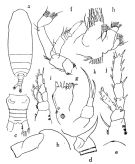 issued from : O. Tanaka in Publ. Seto Mar. Biol. Lab., V (3). [p.400, Fig.21]. As Drepanopsis frigidus. Female: a, habitus (dorsal); b, head (left lateral aspect); c, urosome (dorsal); d, last thoracic segment and genital somite (left side); e, rostrum (ventral aspect); f, A2; g, masticatory edge of Md; h, Mx1; i, P1; j, P2; k, P4.
|
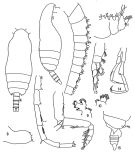 issued from : G.D. Grice & K. Huisemann in Proc. U.S. natn. Mus., 1967, 122 (3583). [p.47, Figs.4-15]. Male (from Indian Ocean): 4, habitus (dorsal); 5, idem (lateral right side); 6, distal end of right A1; 7, proximal part of right A1; 8, Md (mandible blade); 9, Mx1 (1st inner lobe omitted); 10, second basal segment and endopod of Mx1; 11, Mx2; 12, Mxp; 13, P1; 14, P5. Nota: A1 reaches to end of furca. The male is distinguished from F. orba (Tanaka, 1956) by the rounded 5th thoracic segment and the structure of P5. Nota: A1 reaches to end of caudal rami, segments 20-21 fused and 22 of right A1 each with patch of thick hair. 5th thoracic segment small and rounded. P5 asymmetrical, right leg longer than left one. Female: 15, posterior end of thorax and urosome (lateral right side).
|
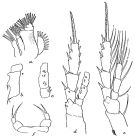 issued from : R.B.S. Sewell in Mem. Indian Mus., 1929, X. [p.97, Fig.39]. As Drepanopsis frigidus. Female (from S India): a, Mx1; b, A2 (2nd exopodal segment); c, P2 (endopod); d, P3; e, P4; f, P5.
|
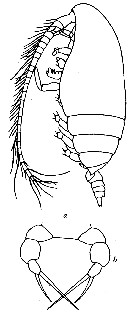 issued from : R.N. Wolfenden in Die Marinen Copepoden der Deutschen Südpolar-Expedition 1901-1903, 1911. [p.246, Fig.29]. As .
Female: a, habitus (lateral); b, P5.
|
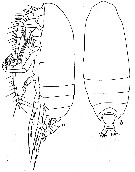 issued from : W. Vervoort in Verh. K. ned. Akad. Wet., Afd. Natuurk., 1951, (Sect. 2) 47 (2). [p.60, Fig.34]. As .
Female (± 66°.5S, 11°W):a-b, habitus (lateral and dorsal, respectively).
Nota : Head and 1st thoracic segment fused (a trace of a line of separation is visible on the sides), 4th and 5th separate. ; postero-lateral thoracic margin triangularly produced, apical portion bluntly pointed, the flap covers less than half the length of the genital segment. Proportional lengths of cephalothorax and abdomen as 49 :9. Frontal organ with apair of minute hairs ; the frontal organ carries a backwardly directed, setiform spine, which is almost hidden between the basal portions of A1.
|
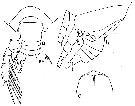 issued from : W. Vervoort in Verh. K. ned. Akad. Wet., Afd. Natuurk., 1951, (Sect. 2) 47 (2). [p.62, Fig.35]. As .
Female: a, posterior part cephalothorax, left P4 and urosome (dorsal); b, idem (lateral; left P5 also visible); c, frontal portion of cephalon (ventral aspect to show the position of the rostrum).
Nota: Urosome very short, 4-segmented ; proportional lengths with the caudal rami 32 :11 :16 :11 :30 = 100. Genital segment broader than long (proportions 17 :15). ; ventrally with a weakly indicated genital tubercle, receptacles distinctly visible, orifices covered by a broadly ovoid genital flap, slightly curved. Anal segment with big, rounded anal flap. Caudal rami as long as broad, 4 marginal setae on each ramus plus 1 small external (dorsal) seta.
|
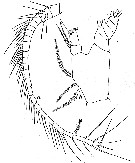 issued from : W. Vervoort in Verh. K. ned. Akad. Wet., Afd. Natuurk., 1951, (Sect. 2) 47 (2). [p.63, Fig.36]. As .
Female: a, left A1; b, Md (mandibular palp).
Nota: A1 short, 24 segmented (8th-9th segments fused), reaching as far as the caudal border of the 3rd thoracic segment., but in other specimen they are slightly longer (reaching almost to the end of the thorax) ; A1 are attached to an elevated portion of the ventral surface of the body which might easily pass for the 1st segment.
|
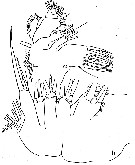 issued from : W. Vervoort in Verh. K. ned. Akad. Wet., Afd. Natuurk., 1951, (Sect. 2) 47 (2). [p.64, Fig.37]. As .
Female: a, right Mx1; b, right Mx2.
Nota: Mx1 with squarish 1st lobe, carrying 9 strong, sabre-like spines, plus 4 smaller setae on the posterior surface ; 2nd and 3rd inner lobe each with 4 setae, the 3rd lobe is spinulose on its posterior surface ; 1st outer lobe small, with 9 setae ; exopod small, with 11 setae ; 2nd basal segment with 5 internal setae (and no spines on its surface as described by Sewell) ; there are 3 well separated segments, the 1st carries 4, the 2nd 5 and the 3rd 7 setae. Mx2 with 5 well developed lobes, there are 3 endopodal segments, the proximal 2 each have 1 seta, the apical has 3 setae (2 strong and 1 small), all these setae are spinulose.
|
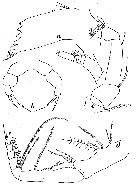 issued from : W. Vervoort in Verh. K. ned. Akad. Wet., Afd. Natuurk., 1951, (Sect. 2) 47 (2). [p.66, Fig.38]. As .
Female: a, Md (cutting edge); b, P5 (posterior aspect); c, right A2; d, left Mxp.
Nota: Endopod of A2 slightly longer than the exopod. P5 symmetrical, the proximal segment coalescent with the chitinous ridge on the ventral border ; the internal and external setae of the distal segment are nude.
|
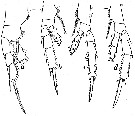 issued from : W. Vervoort in Verh. K. ned. Akad. Wet., Afd. Natuurk., 1951, (Sect. 2) 47 (2). [p.67, Fig.39]. As .
Female: a, right P1 (anterior); b, left P2 (posterior); c, right P3 (posterior); d, right P4 (posterior).
|
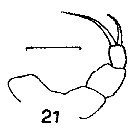 Issued from : J.M. Bradford in N.Z. Oceanogr. Inst., 1971, 206, Part 8, No 59. [p.17, Fig.21]. Female (from 79°09'S, 171°00'W): 21, P5. Scale bar: 100 µm.
|
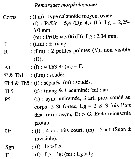 Issued from : C. Razouls in Ann. Inst. océanogr., Paris, 1994, 70 (1). [p.52]. Caractéristiques morphologiques de Farrania frigida femelle et mâle adultes. Terminologie et abbréviations: voir à Calanus propinquus.
| | | | | Ref. compl.: | | | Park, 1970 (p.475); Björnberg, 1973 (p.311, 386); Harding, 1974 (p.141, Table 2, gut contents); Deevey & Brooks, 1977 (p.256, tab.2, as frigidus, Station "S"); Hopkins, 1985 (p.197, Table 1, gut contents); Hopkins & Torres, 1988 (tab.1); Hattori, 1991 (tab.1, Appendix); Razouls & al., 2000 (p.343, tab. 5, Appendix); Schnack-Schiel & al., 2008 (p.1045: Tab.2); Medellin-Mora & Navas S., 2010 (p.265, Tab. 2) | | | | NZ: | 8 | | |
|
Carte de distribution de Farrania frigida par zones géographiques
|
| | | | | | | | | | | |  issued from : W. Vervoort in B.A.N.Z. Antarctic Reseach Expedition, Reports - Ser. B, Vol. III, 1957 [Fig.10]. issued from : W. Vervoort in B.A.N.Z. Antarctic Reseach Expedition, Reports - Ser. B, Vol. III, 1957 [Fig.10].
Chart showing the geographical distribution (white circle) in the seas surrounding the Antarctic continent.
Nota: In this chart the area frequented by whaling vessels has been hatched. The Antarctic circle (66°.5 S) has been drawn as a broken line. The numbers I to VI refer to the sectors into which the Antarctic seas are divided according to Mackintosh (1942) (after Vervoort, 1951). |
| | | | Loc: | | | Antarct. (Croker Passage, Peninsula, Weddell Sea, SW Atlant., South Georgia, SE, Indian, SW Pacif., Ross Sea), Atlant. equatorial (off E St. Paul Ys.), off SW Cape Verde Is., Caribbean Sea, Caribbean Colombia, G. of Mexico, off Bermuda: Station "S" (32°10'N, 64°30'W), Sargasso Sea, off E Cape Cod (42°N, 64°30'W), ? Bay of Biscay, off S Laccadive Is., W Indian, Bay of Bengal, Philippines, China Seas (South China Sea), Japan, off Sanriku, G. of California (? Guaymas Basin), Chile (32° S) | | | | N: | 26 | | | | Lg.: | | | (10) F: 2,35-2,25; (25) F: 3-2,6; (29) F: 2,28; (31) F: 2,9; (35) F: 2,88-2,58; (55) F: 2,95-2,88; {F: 2,25-3,00} | | | | Rem.: | méso à bathypélagique.
Sampling depth (Antarct.) : 500-1000 m.
Un doute subsiste entre les synonymies de F. oblonga et F. frigida, mais la répartition géographique conforte la synonymie.
Voir aussi les remarques en anglais | | | Dernière mise à jour : 24/01/2017 | |
|
|
 Toute utilisation de ce site pour une publication sera mentionnée avec la référence suivante : Toute utilisation de ce site pour une publication sera mentionnée avec la référence suivante :
Razouls C., Desreumaux N., Kouwenberg J. et de Bovée F., 2005-2025. - Biodiversité des Copépodes planctoniques marins (morphologie, répartition géographique et données biologiques). Sorbonne Université, CNRS. Disponible sur http://copepodes.obs-banyuls.fr [Accédé le 03 juillet 2025] © copyright 2005-2025 Sorbonne Université, CNRS
|
|
 |
 |
















